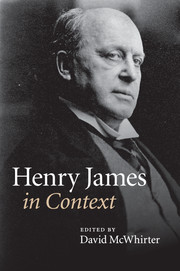Book contents
- Frontmatter
- Contents
- List of Illustrations
- Notes on Contributors
- Preface
- Abbreviations
- Chronology
- Part One Life and career, times and places
- Chapter 1 Nineteenth-century America (1843–1870)
- Chapter 2 Nineteenth-century Europe (1843–1900)
- Chapter 3 Victorian England (1870–1890)
- Chapter 4 Fin-de-siècle London (1890–1900)
- Chapter 5 The twentieth-century world (1901–1916)
- Chapter 6 Autobiographies and biographies
- Chapter 7 Letters and notebooks
- Chapter 8 The James family
- Part Two Historical and cultural contexts
- Part Three Reception
- Further reading
- Index
- References
Chapter 1 - Nineteenth-century America (1843–1870)
Published online by Cambridge University Press: 05 August 2014
- Frontmatter
- Contents
- List of Illustrations
- Notes on Contributors
- Preface
- Abbreviations
- Chronology
- Part One Life and career, times and places
- Chapter 1 Nineteenth-century America (1843–1870)
- Chapter 2 Nineteenth-century Europe (1843–1900)
- Chapter 3 Victorian England (1870–1890)
- Chapter 4 Fin-de-siècle London (1890–1900)
- Chapter 5 The twentieth-century world (1901–1916)
- Chapter 6 Autobiographies and biographies
- Chapter 7 Letters and notebooks
- Chapter 8 The James family
- Part Two Historical and cultural contexts
- Part Three Reception
- Further reading
- Index
- References
Summary
On a summer’s day in 1850, travelling with his father, the religious philosopher and social reformer Henry James Senior, on the ferry from Manhattan to the family’s summer home on Long Island, the 7-year-old Henry James was introduced to Washington Irving. Irving had important news to convey, namely the recent drowning of Margaret Fuller in a shipwreck off nearby Fire Island. As he writes in his 1913 volume of autobiography, A Small Boy and Others, ‘This unfortunate lady was essentially of the Boston connection; but she must have been, and probably through Emerson, a friend of my parents. . . [T]he more I squeeze the sponge of memory the more its stored accretions flow’ (A, 37). Recollection of this encounter with Irving does indeed provoke a further memory, this time of the young James viewing ‘a small full-length portrait of Miss Fuller, seated as now appears to me and wrapped in a long white shawl, the failure of which to do justice to its original my companions denounced with some emphasis’ (37). The intersection of Irving, Fuller and James on the New York ferry neatly orchestrates a tableau of American literary history. Irving, generally regarded as America’s first professional man of letters, had consistently concerned himself with exploring the nation’s complex relationship of attraction and resistance to Europe; Margaret Fuller, friend and one-time Transcendentalist colleague of Ralph Waldo Emerson, had been returning from Europe after a period during which her accounts in the New York Tribune newspaper of the failed Italian revolution of 1848–9 had argued strongly for America’s more cosmopolitan engagement with European culture and politics; James, of course, was to propose and practise a model of authorship that avoided the narrowness of provincialism and nationalism, one that was concerned, instead, to map the transatlantic as both a narrative framework and an epistemological challenge. The three generations of American writing represented by this recalled scene also map on to an historical arc that moves from Irving’s post-Revolutionary moment, to the antebellum culture of Fuller’s New England romanticism, and will end with James’s self-positioning as the figure best equipped to describe the conditions of post-civil war American identity. The sense of failed representation that James remembered as the general response to the Fuller portrait chimes with his own anxieties over the attenuated status of authorship within the American republic of letters at mid century.
- Type
- Chapter
- Information
- Henry James in Context , pp. 3 - 13Publisher: Cambridge University PressPrint publication year: 2010



